Heating with wood is a conscious choice and a complete commitment. There may be no better heat source than that of wood. After all, who doesn’t love a cozy fire?
This post may contain affiliate links at no additional cost to you. By making your purchases through the links on this website, IMSL may make a small percentage at no direct cost to you. IMSL only promotes products we use & truly believe in. Please refer to my Privacy & Disclosures for further information. IMSL thanks you for your support!
Growing up in the iconic New England area, you can be assured when walking outdoors during the fall months of catching a whift of wood burning stoves. There may be nothing that brings me as much joy as that scent when cold weather arrives.
WHY WE CHOSE TO HEAT WITH WOOD
When we built our reproduction cape on our homestead over 16 years ago, we knew we wanted to heat with a renewable, cost effective, & sustainable method. Fossil fuels were definitely not on our radar, especially with the size of our home (approx. 2400 square feet).
I know it’s large. Larger than what we need. However, we did design it so that the entire upper floor can be closed should we choose in our old age 🙂
Being the old souls that we are, we knew we would choose wood as our heat source. Utilizing wood in 3 different ways, as well as by creating the hot water needed for the home, our decision was made. We would heat with wood (say that 3 times fast) in the following manner(s).
- General Heat | Boiler
- Hot Water Heater
- Cookstove
- Fireplace
We longed for a fireplace, and chose a traditional rumford design. In part due to the aesthetic, but more importantly due to the heat it generates into the room instead of up the chimney.
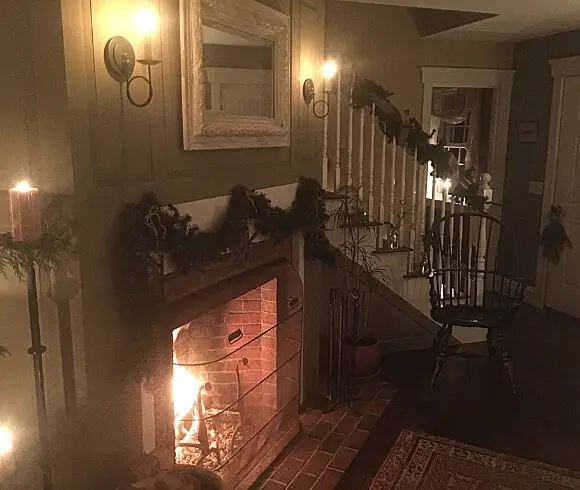
I knew I wanted an antique cookstove, similar to one my Grandmother used. We were fortunate to be able to acquire an early 1900 Glenwood Cookstove. She is the hardworking beauty and focal point of our home. When our power goes out, you can be sure she is up and running at full capacity, offering heat, water, meals, and makeshift clothes dryer to boot.
Keep an eye out on an upcoming post (once the heating season is over) on how I give this beauty a shine up 😉
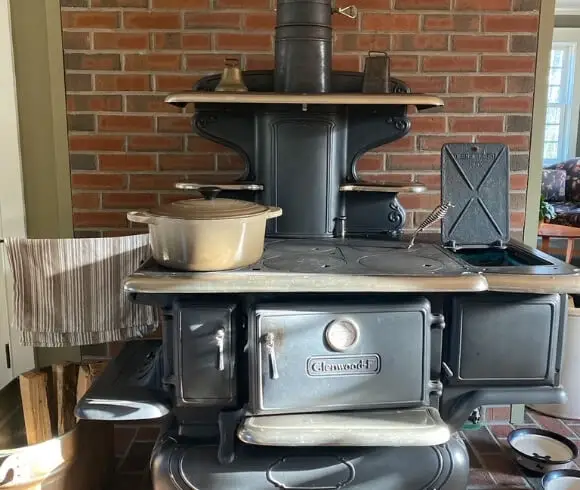
When deciding on which type of boiler to use to heat our entire home efficiently, without waste, and more importantly in a sustainable way, we also knew we wanted our hot water heated for us at the same time.
HOW WE USE A WOOD BURNING BOILER TO HEAT OUR HOUSE
Fortunately, with technology and advancements in wood boilers, the choice became a simple one. We knew we didn’t want to lose BTU’s in any way (we felt outdoor boilers were not a viable option for us with our criteria) and we needed an option to heat our daily water, a hot water tank. We are blessed to have a boiler that does just that. Heats our home & hot water (year-round) using no fossil fuels. The only drawback on the system we chose is that it does require a small amount of electricity to run (an internal fan).
When heat is required, the boiler is lit which in turn begins to run hot water through our antique cast iron heaters we have throughout the house. These cast iron heaters maintain their heat very efficiently. These cast iron heaters also act as a humidifier for our dry home by placing a bowl of water on top of each. Win, win!
On the occasions we do lose our lights, we utilize a generator to run the boiler or simply fire up the cookstove and fireplace to generate our heat.
PRO’S & CON’S OF HEATING WITH WOOD
It is definitely a heating source that is not for everyone! It is a commitment, even more so when utilizing a pellet stove or woodstove as you need to be available to fill it often unless you are blessed to have one with a catalytic converter which allow you to set your temperature and go. Your location & health can also be a hindrance should you want to use this method of heating.
That being said, I can only attest to our experiences with heating with wood. As with any heat source, there are pro’s and con’s to be found.
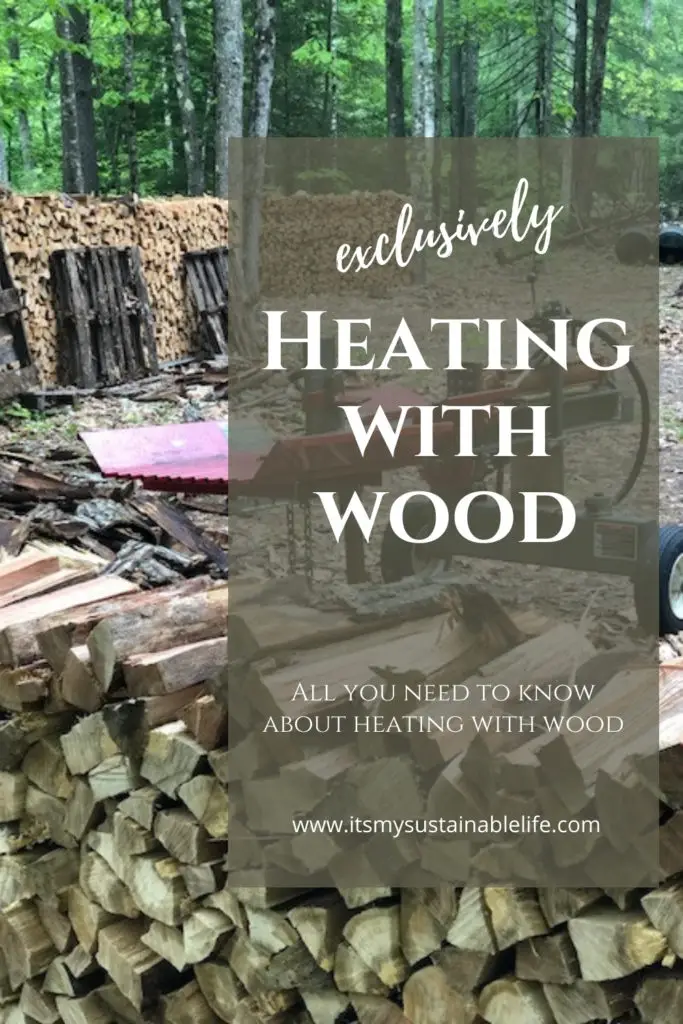
Choosing to heat with wood is no different. After relying on wood completely for the past 16+ years, we have learned a few lessons for sure!
WOOD – THE HEAT SOURCE THAT HEATS YOU SEVERAL TIMES OVER
After all, we are not afraid of physical labor, and in fact enjoy it, and you can be sure that when chosing to heat with wood you will be the beneficiary of a good workout 😉
“Chop your own firewood and it will warm you twice”
Chinese Proverb
It is said that by heating with wood you will be warmed several times over. We can attest to that fact for sure! And it definitely is more than twice! Although it is a physical labor, it is also a labor of love. Love for ourselves & for our environment.
IT’S ECONOMICAL – HOW MUCH IT COST US TO HEAT WITH WOOD
The photo below is an image of just a bit of the wood we require for a year’s worth of heat and hot water usage. Typically our household with go through approximately 5 cords of wood per year. This 5 cord of wood supplies not only the wood boiler for both heat and hot water, but also provides enough wood to run the cook woodstove and fireplace as well.
To give you an idea of how much a cord of wood is, a cord measures about 4 feet by 4 feet by 8 feet of neatly stacked wood, or 128 cubic feet of stacked wood.
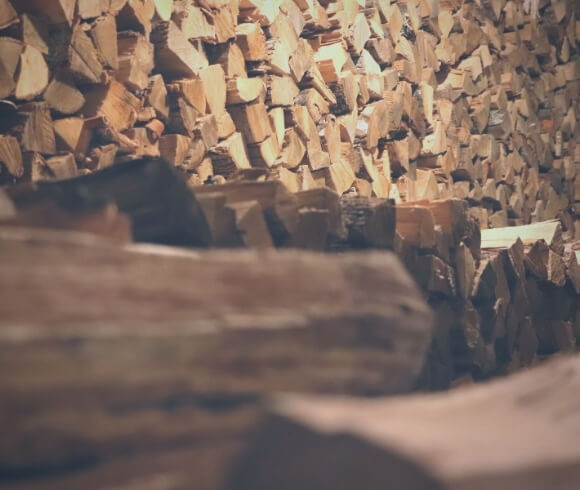
So the 5 cord of wood needed to maintain heat and hot water here on the homestead comes to a whopping 4 feet by 4 feet by 40 feet of wood. That’s a lot of wood. Our average cost per year for both heat and hot water is $900 to $1100, depending on the year. Not too shabby! And that’s with about 3 cord leftover each year!!
By purchasing our wood by the cherry picker load (full log lengths) and processing the wood ourselves, we save over $1500 on heat and hot water (not including the additional 3 cord we usually have leftover).
If we were to have to purchase wood that has already been processed & typically “seasoned”, more on the terms you should know about heating with wood below, that would run us approximately $200 to $400 (or more in some parts) per cord! That is about $2000 per year!
I don’t know about you, but that’s a lot of $$$. Still, it’s cheaper than running other fossil fuels (gas or oil), which can run anywhere between $1250 to $2200 just for heat alone. Add approximately $438 to generate your hot water per year, & you are totaling anywhere between $1688 to $2638!
I think we’ll stick with our measly $1100 bill & a good workout, just sayin’ 🙂
IT’S A RENEWABLE RESOURCE
Here in New England we are blessed to be surrounded by, well, wood. Over 84% is considered woodland to be exact here in my State. It is readily available, renewable (especially when forrested correctly), sustainable, and local. What more could I ask for?
Should you be concerned with “keeping it local”, there may be no better way to heat your home if you are in a location with such resources. There is something to be said about keeping the dollars spent local and in your own area.
IS THERE A HEALTH CONCERN FOR HEATING WITH WOOD
Judgement is out on whether or not heating with wood can be a concern for certain health issues, think asthma, or those with heart or lung issues. Several factors play a part in many of these opinions. How well is your house sealed during the winter, does your house breathe? And the age of your woodburning appliance, how old is it?
We have never experienced health issues from heating with wood. Our wood boiler is a newer, extremely efficient model that releases very little “exhaust” into the atmosphere, instead turning that “exhaust” into additional BTU’s (keep a look out for an entire article on the model we chose & why coming soon). Our home is well ventilated, and we don’t hesitate to crack a window should additional drafts be needed.
THE COMMITMENT TO HEATING WITH WOOD
The commitment to heating with wood is actually a pro and a con in my opinion. The pro in my mind is that it is a lifestyle choice. A choice to get back to being a bit more self-sustaining in all ways, and that includes our heat sources.
With that in mind, the commitment to heating with wood can also be, well, a commitment. You need to be home to start the fires or schedule someone to do so for you. You need to commit to several weeks of cutting, splitting, and stacking the wood with an additional weekend to bring the wood in when it’s ready to use. It is that. A commitment, but one we wouldn’t change.
Optionally, you can opt to install a backup source of heat. Down the road, to allow for a bit more travel during the winter months, we may opt to install a propane heater. One that we can set low and go.
TYPES OF WOOD BEST SUITED FOR HEATING
We are fortunate that we live an area of the country with a pretty good supply of wood for heating. What? All wood is not considered appropriate “wood for heating”? You got it. Like with most things, certain wood burns better and is more conducive to heating the home efficiently & safely than others.
If you are considering a wood burning stove or boiler for your home, it is imperative that you know what type of wood is available in your area, and what types of wood are best for heating with. Certain wood types burn at different rates, think high, medium, and low heat values. This is due to their density and water content. The more dense a piece of wood, the drier it will become, the better the heat and burning times.
Below are a few of the wood varieties that are available in our neck of the woods along with their corresponding heat values. These varieties that are considered “hardwoods” (more dense wood with less sap/water content) are best suited for heating the home.
- ASH
- BEECH
- BIRCH (RED & WHITE)
- MAPLE
- OAK
All but the birch varieties are considered possessing “high heat” values, translating into 1 cord of wood is roughly equal to 250 gallons of oil for fuel.
The only wood I would caution of burning too much of is pine. Pine, a softwood with not a lot of heat value & contains high amounts of sap. This high level of sap content can be potentially dangerous as it creates a “coating” on the inside of your liners and flues. The buildup of these deposits, also known as creosote (a known fire hazard) within your chimney, can lead to fires within the home.
BASIC WOOD FOR HEATING TERMS
When first beginning, learning a few “wood terms”, especially when purchasing your cord wood already processed, can make all the difference when trying to choose which to purchase.
I will say this. Know and talk with the individual you will be purchasing your wood from. Know the terms below, do your research, & get quotes and referrals from several sources. I’m sad to say not all loggers are created equal, if you get my meaning 😉
HEAT VALUE – Heat value refers to the amount of heat produced when burning specific types of wood. When choosing your wood varieties, choose those with a high heat value for value on the dollar
GREEN WOOD – Freshly cut wood will contain 50 percent water and well, water doesn’t burn. In order for the wood to burn properly and produce optimal heat value, the wood needs to season. Green wood is wood that has a moisture content of 25% or higher, is considered “wet” and should not be burned
SEASONING – Seasoned wood is wood that has been cut and left to dry for long periods of time, typically at least six months if not longer. How do you tell if your wood is seasoned properly? The ends should be dark with visible splits or cracks. If when you burn the wood and it “hisses”, it’s a pretty good indication that it is not seasoned properly and needs to dry out longer. Properly seasoned wood will have a moisture content of only 20 to 25%.
SPLIT WOOD – Split wood is just that. Wood that has been processed, cut, and split to a length that will easily fit your wood burning apparatus
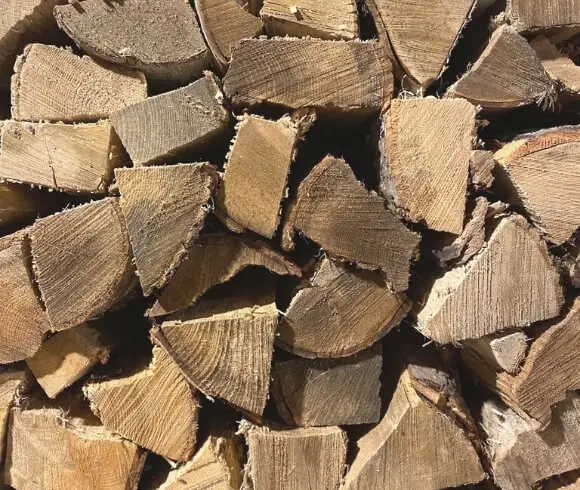
STORING YOUR WOOD
Depending on the weather of where you live, you may want to cover your stacked wood piles in some way to keep the elements off the wood to help keep it as dry as possible.
With wood that has not been thrown down into our cellar for dry storage or placed into our woodshed, the 3 cord leftover each year, we use tarps over the top of the piles only. No need to worry about the sides of the pile. This keeps the pile sufficiently dry from rain and snow, yet still allows air-flow to continue to dry the pile.
In the home, for convenience, we store the majority of our wood in our basement for use with the wood boiler. As the antique cookstove only accepts a shorter length wood, we’ve created a beautiful space to store the wood just outside our door. This wood is then placed into an antique copper tub beside the cookstove as needed.
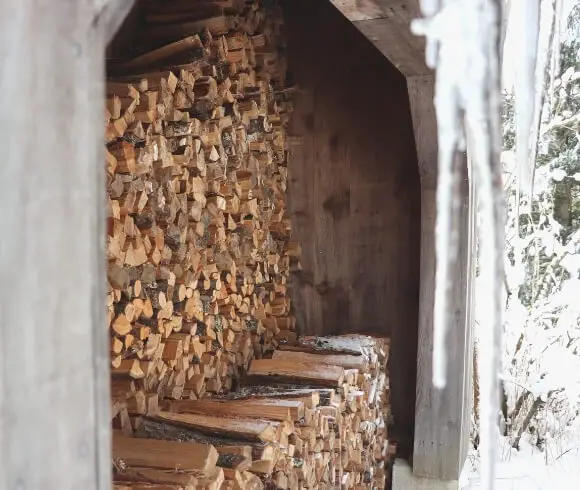
For wood needed when we light the fireplace, we use the wood in our cellar, bring it up using a wood bag, and store it upright in an old crock.
There are many storage boxes and options, but these are what we had on hand and work efficiently & beautifully.
SAFETY WHEN HEATING WITH WOOD
One of the biggest questions we receive is, “is it safe to heat with wood”. My response? Yes, with a few safety precautions.
~ The biggest safety measure anyone can do in my opinion when you are heating with wood is keeping up with general maintenance.
~ Cleaning the flue’s & chimney(s), for us several times a year.
~ Educating yourself on both the woodstove option you choose as well as the wood you will be burning.
~ Following the manufacturers recommendations and state & municipality requirements to the letter. Establishing clearance(s), sprinkler systems (required in our area for the indoor woodboiler), and instituting them.
~ Using commonsense, taking appropriate precautions, and don’t become lax in your safety measures.
COOKING ON THE WOODSTOVE
People are always amazed when I speak about cooking on our woodstove. I have to say, there may be no greater pleasure than doing just that. Maybe I’m channeling the energy of my Grandmother, powerhouse woman that she was, not only cooking daily but canning on hers!
When we were first building, this cook woodstove was the only stove we had. We learned pretty darn quickly how to cook using it 🙂
To this day, when the cook woodstove is up and running, we cook exclusively on it, both on the stove top as well as in the oven. Be sure to keep an eye out for an article surrounding doing just that!
Heating with wood is definitely a choice. A choice not for many, but one that we wouldn’t alter in any way.
Are you heating with wood?
Love, Light, & Laughter ~


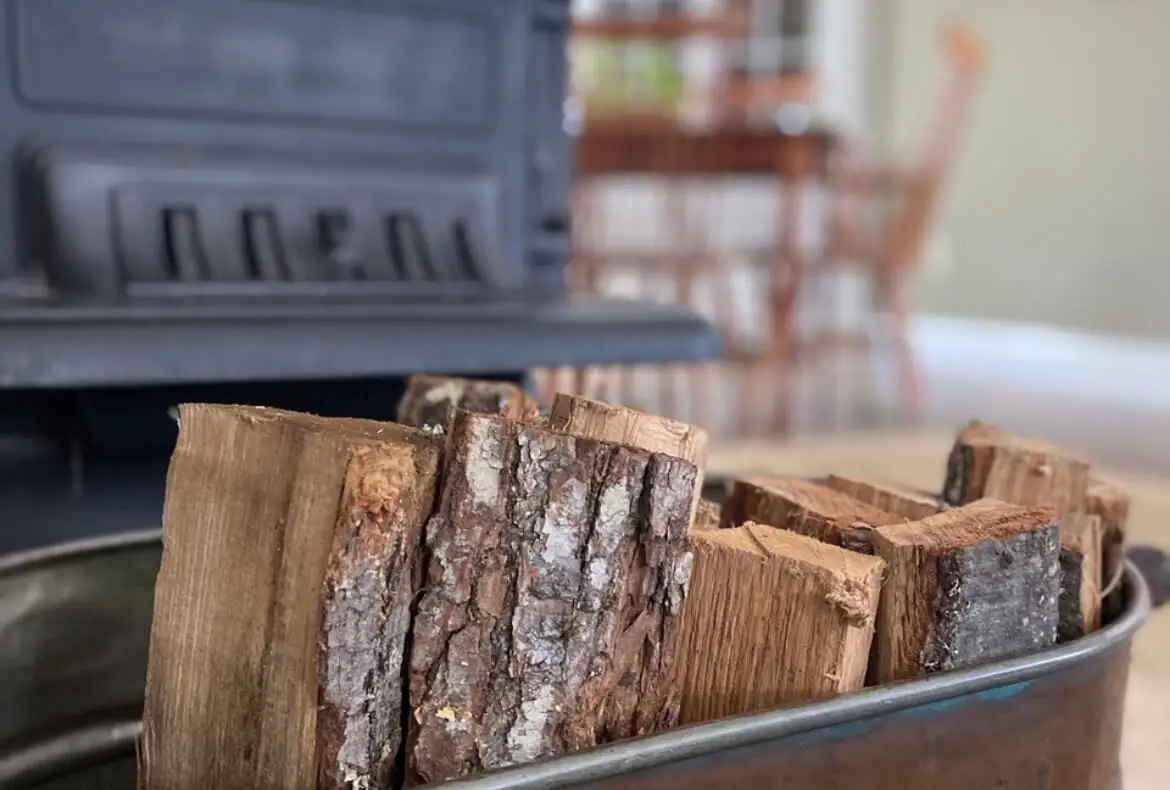
32 comments
We used wood almost exclusively for all the years we lived in Montana. My husband actually loved to go out into the mountains and cut wood. We moved to NC to be closer to our grandkids and we have a wood stove here. The temps don’t get as low as Montana but with the humidity, it FEELS much colder so the wood stove is nice.
Nothing quite like a nice wood stove burning on a cool day! Thank you for sharing your thoughts & memories of heating with wood!
I love having a roaring fire in the winter!
I have friends that heated their home with wood, using an outdoor unit that they fed the wood into and then it was ducted through the house. It is a huge commitment but they loved it too. The only other negative I’ve personally encountered is it can be more difficult to sell a home with wood as the only heat source. A listing I had, as a realtor, couldn’t qualify for a loan for the buyers because of the wood heat so the sellers had to pay to install a traditional heat/air unit.
It can be an issue. We will be installing a backup system as well, so hopefully, should we ever decide to sell this will not be an issue.
Great info! Thanks for sharing!
Wow! This was an interesting read! My grandparents used their fireplace often to heat their home (they had a furnace, but opted to turn it off). I remember the stacks of wood in their yard as well.
When I was growing up, the only heat we had in our house was the woodstove. I would love to get back to that.
Excellent post! We would love to be able to heat with wood! Lisa was able to during her time in Alaska! Thank you so much for sharing the benefits!
What a great comprehensive post about heating with wood! I’m one of those that might shy away from it just because I get really sensitive to smoke in my lungs and sinuses when we go camping, so I would have to be really sure that wouldn’t become an issue in our environment. But…I would definitely love to learn to cook on a wood-burning stove someday!
Great post! We also heat with wood to supplement our in-floor heating and propane boiler in the subarctic. We go through 10 cords of wood each year. Thanks for sharing at The Homestead Blog Hop!
I would love to stay at place for a long weekend to try this out! I am curious to see if I was up to the task!
That would be a great way to experience it!
This was incredibly interesting; I personally love the smell of burning wood and it seems so organic to be able to run your entire house in this way. Very informative!
We also heat with wood in an outdoor stove that also heats our hot water. It is very affordable and an excellent way to heat water and multiple buildings.
I would love to heat my future home with wood! Thank you for all the awesome info.
Your stove is amazing. Gorgeous. I love the idea of heating only with wood… But storing all that wood would definitely be something that takes planning lol!
It does take some initial planning. The good news? Once you have a system in place, it’s, well, in place. Thanks for stopping by!
The smell that permeates through your house must be so amazing. I definitely miss having a wood burning fireplace.
Really no smell until you step outside. Then you can enjoy the scent. Thanks so much for reading!
What a beautiful stove! This is so much useful information.
I truly enjoyed this article – knew a lot about using wood, but learned a great deal more. I have cooked meals using a wood burning stove, and I swear the food tastes so much better – or is it only me? However, the smell of a wood burning fireplace is so wonderful and I know that’s not just me.
You are so very brave for having your whole house system using wood, but it’s obvious that y’all know what you’re doing. Very impressive!
I couldn’t agree more, Roselyn. There definitely is an added benefit in the food tasting amazing when cooked on our woodstove. Like you, not sure if it’s just satisfaction or taste. Thank you for reading!
I have chopped my own firewood and that is definitely true!
That’s a LOT of wood for your awesome stove!!
Stoves. As in 3 to be exact 🙂
Great information! We are currently using a corn stove, but my husband would like to convert it to wood!
Great post!
We love our wood heat!
I love heating with wood! You have an amazing stove! Thank you for the great tips!
Thank you, Holly. She is a working horse here on the hill!
I bet! Stay. Warm and happy!
Very informative. I remember when I was younger and visiting one of my uncles how is home was cozy and warm.